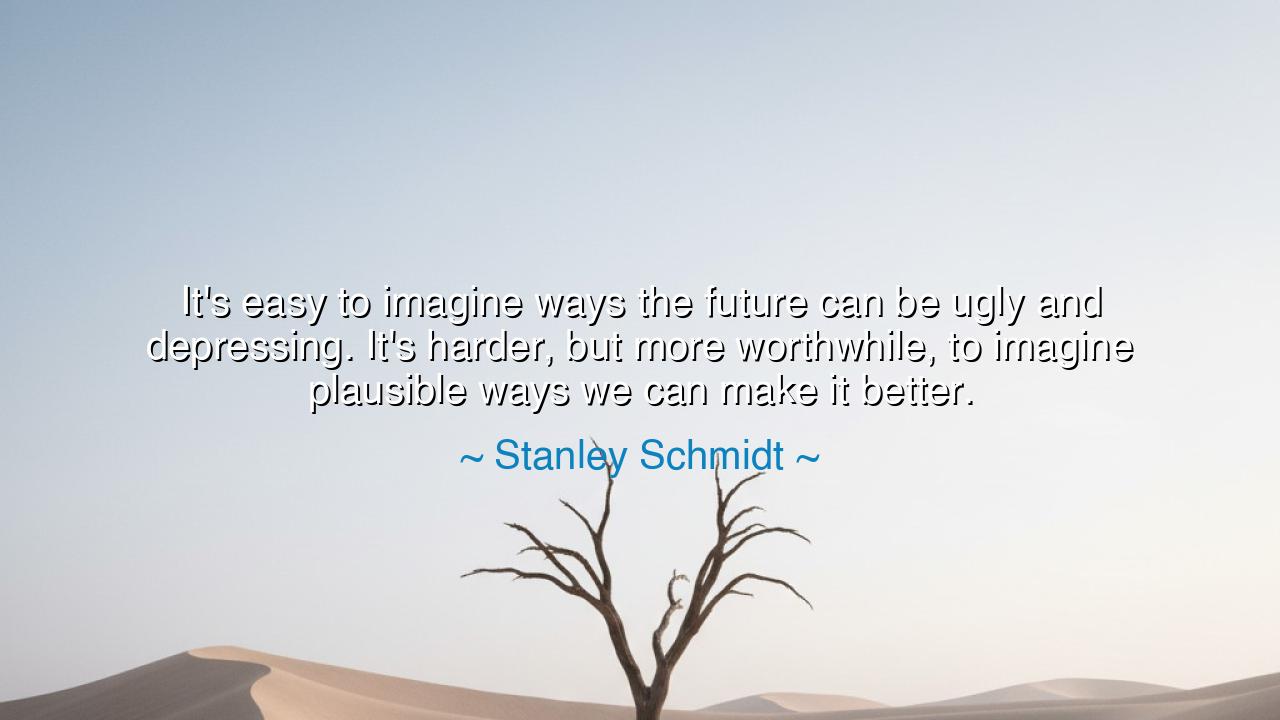
It's easy to imagine ways the future can be ugly and depressing.
It's easy to imagine ways the future can be ugly and depressing. It's harder, but more worthwhile, to imagine plausible ways we can make it better.






"It's easy to imagine ways the future can be ugly and depressing. It's harder, but more worthwhile, to imagine plausible ways we can make it better." These wise words from Stanley Schmidt speak to a fundamental truth about the human condition: while it is often simpler to envision a bleak or dark future, it takes far more courage, imagination, and hope to conceive of a future full of possibility and progress. The easy path is to succumb to fear, to dwell on what is wrong, to predict the collapse of everything we hold dear. But true greatness is found in those who dare to see beyond the immediate struggles and envision a world that can be better, one where the seeds of hope and action can blossom into something brighter.
In ancient times, the prophets and philosophers were revered not just for their wisdom but for their ability to see beyond the present moment. They understood that the future was not a preordained fate but a canvas that could be shaped by human hands. Plato, in his Republic, spoke of the ideal society, a vision of harmony, justice, and wisdom. Though the path to that ideal was difficult, he still imagined a better future, one where the people would live in a society shaped by reason rather than chaos. He did not simply accept the present suffering but sought a way to transcend it and lead others toward something greater. Similarly, Confucius spent his life teaching about the cultivation of virtue and the importance of creating a better society, showing that the future could be shaped by the character of individuals.
As we move through history, we see that the great leaders and visionaries were those who understood that the future could be molded by action, by thoughtful decisions, and by the courage to dream of better possibilities. Abraham Lincoln is one such figure, a man who faced a fractured nation and yet believed, despite the overwhelming odds, in a future where freedom and equality could unite a divided land. Lincoln did not look at the ugliness of his time—his nation torn apart by slavery and civil war—and accept it as a permanent state. Instead, he imagined a better future, a reunion of the states, and fought with every ounce of his being to make it a reality.
Stanley Schmidt’s words, though grounded in modernity, reflect the same spirit of vision and action that has marked the most transformative periods in history. It is easy to be swept away by the dark clouds of despair, especially in a world that often seems to be overwhelmed by challenges. Climate change, social injustice, economic disparity—these are issues that seem impossible to overcome, and it is far easier to dwell on the potential collapse of societies than to find ways to solve these problems. Yet, it is the visionaries, those who dare to imagine how we might improve our world, who inspire action. Just as Martin Luther King Jr. envisioned a world of racial equality despite the oppressive systems of his time, we too must see beyond the present suffering and imagine a better future for all.
The lesson in Schmidt’s quote is clear: it is not enough to see the future as a continuation of our current struggles; we must also imagine and create the future we desire. This is the challenge for every individual, every community, and every nation. To solve the problems we face, we must begin by seeing the solutions—not as distant, unattainable dreams, but as plausible outcomes that we can begin to work toward today. Education, collaboration, and innovation are the keys to building a future that is better than the one we face today. Every action, no matter how small, can contribute to this vision.
In your own life, ask yourself: What vision do I hold for the future? Do I see only the challenges, or do I see the possibilities that lie beyond them? It is easy to become overwhelmed by the obstacles before us, but the harder path, as Schmidt suggests, is the one that leads us toward change. It is the path of hope, creativity, and action. Choose to envision a future where kindness, wisdom, and action lead the way, and then take the steps to bring that vision to life.
Thus, as we walk forward in this world, let us be the ones who dare to imagine a better tomorrow, one where we do not accept the ugliness of today as the final word, but where we take the responsibility to shape the future with our ideas and actions. Just as the great philosophers, leaders, and visionaries of the past shaped the world through their courage to dream, so too can we. The future is not a place we go—it is a place we create, and it begins with the vision we hold today.






AAdministratorAdministrator
Welcome, honored guests. Please leave a comment, we will respond soon